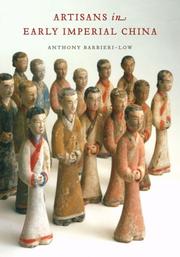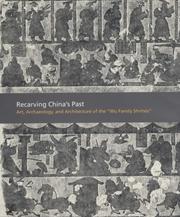| Listing 1 - 10 of 10 |
Sort by
|

ISBN: 9780295987132 0295987138 9780295749389 0295749881 Year: 2007 Publisher: Seattle : University of Washington Press : Published with the assistance of the Getty Foundation,
Abstract | Keywords | Export | Availability | Bookmark
 Loading...
Loading...Choose an application
- Reference Manager
- EndNote
- RefWorks (Direct export to RefWorks)
Artisans --- History. --- Social life and customs. --- Histoire --- Moeurs et coutumes --- S11/0534 --- S11/0490 --- S17/0214 --- China: Social sciences--Class studies --- China: Social sciences--Society: general --- China: Art and archaeology--Archaeology China: Pre-Han and Han --- Artizans --- Craftsmen --- Craftspeople --- Craftspersons --- Skilled labor --- Cottage industries --- History --- Social life and customs
Book
ISBN: 9780295748894 0295748893 9780295748900 0295748907 Year: 2021 Publisher: Seattle, WA : University of Washington Press,
Abstract | Keywords | Export | Availability | Bookmark
 Loading...
Loading...Choose an application
- Reference Manager
- EndNote
- RefWorks (Direct export to RefWorks)
"Although they existed more than a millennium apart, the great civilizations of New Kingdom Egypt (ca. 1548-1086 BCE) and Han dynasty China (206 BCE-220 CE) shared intriguing similarities. Both were centered around major, flood-prone rivers--the Nile and the Yellow River-and established complex hydraulic systems to manage their power. Both spread their territories across vast empires that were controlled through warfare and diplomacy and underwent periods of radical reform led by charismatic rulers--the "heretic king" Akhenaten and the vilified reformer Wang Mang. Universal justice was dispensed through courts, and each empire was administered by bureaucracies staffed by highly trained scribes who held special status. Egypt and China each developed elaborate conceptions of an afterlife world and created games of fate that facilitated access to these realms. This groundbreaking volume offers an innovative comparison of these two civilizations. Through a combination of textual, art historical, and archaeological analyses, Ancient Egypt and Early China reveals shared structural traits of each civilization as well as distinctive features"--
Civilization, Ancient. --- Comparative civilization. --- Egypt --- China --- Civilization --- History --- Civilization, Ancient --- Comparative civilization --- Ancient civilization --- Civilization, Comparative --- S02/0200 --- S02/0300 --- S04/0520 --- China: General works--Civilization and culture, nation, nationalism --- China: General works--Chinese culture and the World and vice-versa --- China: History--Han: 206 B.C. - 220 A.D
Book
ISBN: 9780295750224 0295750227 Year: 2022 Publisher: Seattle University of Washington Press
Abstract | Keywords | Export | Availability | Bookmark
 Loading...
Loading...Choose an application
- Reference Manager
- EndNote
- RefWorks (Direct export to RefWorks)
"The First Emperor of China (259-210 BCE) is recognized as one of the pivotal figures in world history, alongside other great conquerors and political innovators such as Alexander the Great, Genghis Khan, and Julius Caesar. His accomplishments are undeniable, including the conquest of the six other warring states of China, his creation of the imperial bureaucratic system that endured for 2,000 years, and his unification of Chinese culture through the promotion of a single coinage, unified weights and measures, and one writing system. Since his dynasty was cut off a few short years after his death, concrete information on the critical period in Chinese history he occupied has been lacking until recent decades. Only a single, biased historical account, written a century after his death, narrates his biography. In the last forty years, however, archaeologists have revealed not only the lavish burial pits associated with his tomb, but also thousands of legal and administrative documents dating to the Qin period that demonstrate how his dynasty actually functioned. Debates surrounding the historical evaluation of the First Emperor have raged since shortly after his demise. For thousands of years, the character of the First Emperor has become an ideological slate upon which politicians, revolutionaries, poets, painters, archaeologists, and movie directors have written their own biases, fears, and fantasies. He has remained a critical touchstone for Chinese politics and culture, criticized by those supporting Confucian values, lionized by those supporting revolution and nationalism, and romanticized by those fascinated with his terracotta warriors. This volume unravels the discourse concerning this remarkable man of the past as a means to better understand ourselves in the present and provides a cultural history of the First Emperor of China from multiple perspectives. This is not another biography of the First Emperor, nor a detailed history of the Qin dynasty. Rather, it looks historically at interpretations of the First Emperor in historiography, legends, literature, archaeology, and popular culture as a way to understand the interpreters as much as the subject of their interpretations. It will appeal to both academic and general readers interested in Chinese history, politics, and culture, both ancient and modern."--Provided by publisher.
Qin Shi Huang --- Historiography. --- China --- China --- Kings and rulers --- Historiography. --- History --- Historiography.
Book
ISBN: 0295750235 9780295750231 9780295750224 0295750227 Year: 2022 Publisher: Seattle, Washington : University of Washington Press,
Abstract | Keywords | Export | Availability | Bookmark
 Loading...
Loading...Choose an application
- Reference Manager
- EndNote
- RefWorks (Direct export to RefWorks)
"The First Emperor of China (259-210 BCE) is recognized as one of the pivotal figures in world history, alongside other great conquerors and political innovators such as Alexander the Great, Genghis Khan, and Julius Caesar. His accomplishments are undeniable, including the conquest of the six other warring states of China, his creation of the imperial bureaucratic system that endured for 2,000 years, and his unification of Chinese culture through the promotion of a single coinage, unified weights and measures, and one writing system. Since his dynasty was cut off a few short years after his death, concrete information on the critical period in Chinese history he occupied has been lacking until recent decades. Only a single, biased historical account, written a century after his death, narrates his biography. In the last forty years, however, archaeologists have revealed not only the lavish burial pits associated with his tomb, but also thousands of legal and administrative documents dating to the Qin period that demonstrate how his dynasty actually functioned. Debates surrounding the historical evaluation of the First Emperor have raged since shortly after his demise. For thousands of years, the character of the First Emperor has become an ideological slate upon which politicians, revolutionaries, poets, painters, archaeologists, and movie directors have written their own biases, fears, and fantasies. He has remained a critical touchstone for Chinese politics and culture, criticized by those supporting Confucian values, lionized by those supporting revolution and nationalism, and romanticized by those fascinated with his terracotta warriors. This volume unravels the discourse concerning this remarkable man of the past as a means to better understand ourselves in the present and provides a cultural history of the First Emperor of China from multiple perspectives. This is not another biography of the First Emperor, nor a detailed history of the Qin dynasty. Rather, it looks historically at interpretations of the First Emperor in historiography, legends, literature, archaeology, and popular culture as a way to understand the interpreters as much as the subject of their interpretations. It will appeal to both academic and general readers interested in Chinese history, politics, and culture, both ancient and modern"--
Qin shi huang, --- Historiography. --- China --- Kings and rulers --- History --- Qin Shi Huang --- 221-207 B.C.
Year: 2007 Publisher: Seattle Londres University of Washington Press
Abstract | Keywords | Export | Availability | Bookmark
 Loading...
Loading...Choose an application
- Reference Manager
- EndNote
- RefWorks (Direct export to RefWorks)
Book
ISBN: 9789004292833 9789004300224 9789004300231 9789004300538 9004300538 9004292837 9004300228 9004300236 Year: 2015 Volume: 126 Publisher: Leiden ; Boston : Brill,
Abstract | Keywords | Export | Availability | Bookmark
 Loading...
Loading...Choose an application
- Reference Manager
- EndNote
- RefWorks (Direct export to RefWorks)
Law, State, and Society in Early Imperial China has been accorded Honorable Mention status in the 2017 Patrick D. Hanan Prize (China and Inner Asia Council (CIAC) of the Association for Asian Studies) for Translation competition. In Law, State, and Society in Early Imperial China , Anthony J. Barbieri-Low and Robin D.S. Yates offer the first detailed study and translation into English of two recently excavated, early Chinese legal texts. The Statutes and Ordinances of the Second Year consists of a selection from the long-lost laws of the early Han dynasty (206 BCE-220 CE). It includes items from twenty-seven statute collections and one ordinance. The Book of Submitted Doubtful Cases contains twenty-two legal case records, some of which have undergone literary embellishment. Taken together, the two texts contain a wealth of information about slavery, social class, ranking, the status of women and children, property, inheritance, currency, finance, labor mobilization, resource extraction, agriculture, market regulation, and administrative geography.
S06/0201 --- S06/0202 --- S08/0300 --- S11/0491 --- S04/0500 --- S17/0214 --- China: Politics and government--Government and political institutions: pre-Han --- China: Politics and government--Government and political institutions: Han - 589 --- China: Law and legislation--General works and codices: general and before 1949 --- China: Social sciences--Society before 1840 --- China: History--Ancient (Pre-Han and Han, incl. Sima Qian) --- China: Art and archaeology--Archaeology China: Pre-Han and Han --- Law --- Inscriptions, Chinese --- History --- China --- 202 B.C. - 220 A.D. --- China.

ISBN: 0300107978 Year: 2005 Publisher: Princeton Princeton university. Art museum
Abstract | Keywords | Export | Availability | Bookmark
 Loading...
Loading...Choose an application
- Reference Manager
- EndNote
- RefWorks (Direct export to RefWorks)
Art, Chinese --- Decorative arts --- History --- S17/0214 --- S17/1600 --- S17/0801 --- S17/2125 --- China: Art and archaeology--Archaeology China: Pre-Han and Han --- China: Art and archaeology--Architecture --- China: Art and archaeology--Steles and rubbings --- China: Art and archaeology--Musea and exhibitions: USA --- Exhibitions --- Wu family --- Tombs. --- China
Book
ISBN: 9004300538 Year: 2015 Publisher: Leiden ; Boston : Brill,
Abstract | Keywords | Export | Availability | Bookmark
 Loading...
Loading...Choose an application
- Reference Manager
- EndNote
- RefWorks (Direct export to RefWorks)
Law, State, and Society in Early Imperial China has been accorded Honorable Mention status in the 2017 Patrick D. Hanan Prize (China and Inner Asia Council (CIAC) of the Association for Asian Studies) for Translation competition. In Law, State, and Society in Early Imperial China , Anthony J. Barbieri-Low and Robin D.S. Yates offer the first detailed study and translation into English of two recently excavated, early Chinese legal texts. The Statutes and Ordinances of the Second Year consists of a selection from the long-lost laws of the early Han dynasty (206 BCE-220 CE). It includes items from twenty-seven statute collections and one ordinance. The Book of Submitted Doubtful Cases contains twenty-two legal case records, some of which have undergone literary embellishment. Taken together, the two texts contain a wealth of information about slavery, social class, ranking, the status of women and children, property, inheritance, currency, finance, labor mobilization, resource extraction, agriculture, market regulation, and administrative geography.
Law --- Inscriptions, Chinese --- 202 B.C. - 220 A.D. --- China --- China. --- China --- History
Book

ISBN: 9780824874223 Year: 2017 Publisher: Honolulu
Abstract | Keywords | Export | Availability | Bookmark
 Loading...
Loading...Choose an application
- Reference Manager
- EndNote
- RefWorks (Direct export to RefWorks)
Digital

ISBN: 9780824874223 9780824867812 Year: 2017 Publisher: Honolulu, Hawaii University of Hawaii Press
Abstract | Keywords | Export | Availability | Bookmark
 Loading...
Loading...Choose an application
- Reference Manager
- EndNote
- RefWorks (Direct export to RefWorks)
| Listing 1 - 10 of 10 |
Sort by
|

 Search
Search Feedback
Feedback About UniCat
About UniCat  Help
Help News
News